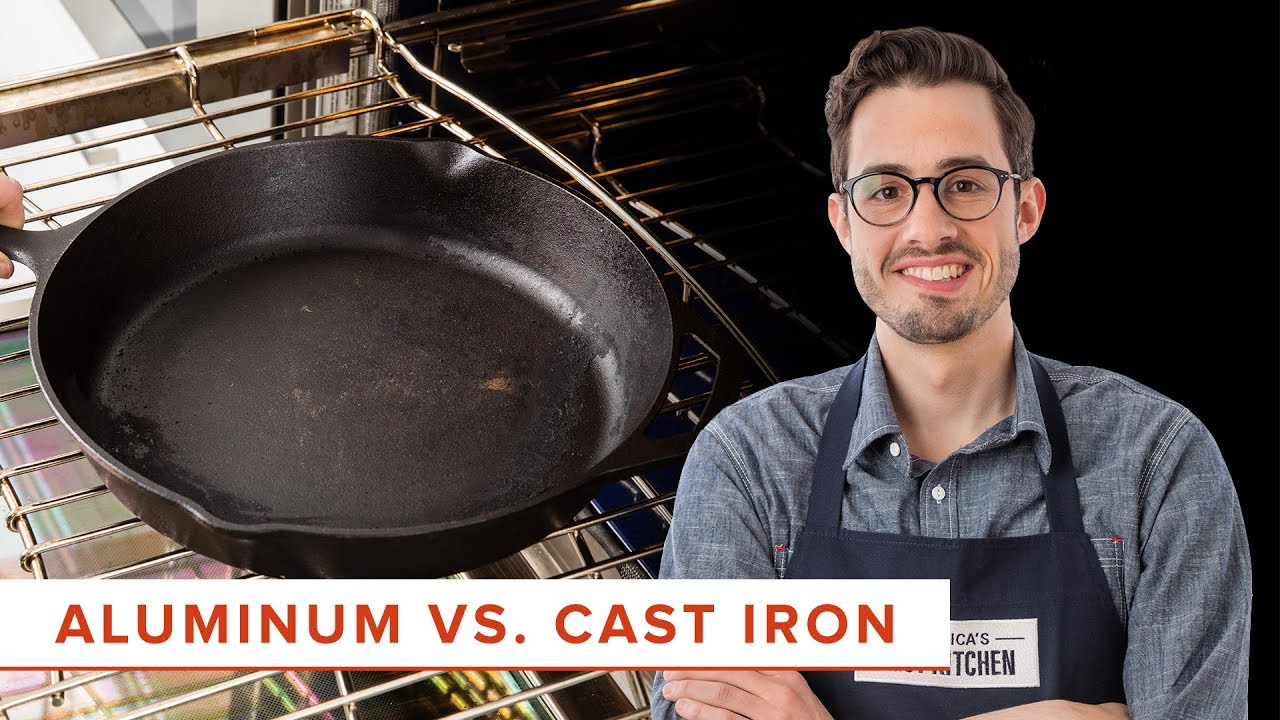Dan explains the heat conduction and retention power of aluminum and cast-iron pans.
ABOUT US: Located in Boston’s Seaport District in the historic Innovation and Design Building, America’s Test Kitchen features 15,000 square feet of kitchen space including multiple photography and video studios. It is the home of Cook’s Illustrated magazine and Cook’s Country magazine and is the workday destination for more than 60 test cooks, editors, and cookware specialists. Our mission is to test recipes over and over again until we understand how and why they work and until we arrive at the best version.
If you like us, follow us:
Related posts
24 Comments
Leave a Reply Cancel reply
You must be logged in to post a comment.


I don't agree, my cast iron heats fast, within a few minutes I'm at medium 246 degrees. This is bad information.
Nice video. Why oh why do modern folk season irons with a rubdown at 400°F-500°F? Of course it'll make for uneven cooking. It should be seasoned by filling with olive oil (yes, pricey or melted crisco to the top, and placed on range burner at lowest possible flame, an hour or so for many generations' use, most even heat, easiest cleanup and reseason with a swipe.
waht about forged iron pans
But is it worth the weight? 😉
Aluminum is TOXIC! Cast Iron is not. Heat retention/dissipation doesn’t matter.
Hum… maybe this is my own ignorance talking, but I wish you hadn't used induction for this test. Or rather, I'd like to know more about the efficiency of induction with different cookware compositions. Is it really transferring the same amount of energy to a big slab of iron as it is to a hunk of aluminum with a wafer-thin layer of stainless steel?
I have a 12 inch KenHom carbon steel wok that I seasoned and I am happy with the way it works on my electric stove. I am thinking of getting an induction plate. I wonder how the wok would perform? Any thoughts to help me?
Dan is hot!!!
do science of ramen noodles and alkalinity explanations please
dan isnt the all clad ss with an aluminium middle layer
You just put the cast iron on high on the burner, then drop it down to the temp you want.
Dan's the man!
wuzz!
Hola!
Grilled cheese
What?
These educational videos are wonderful and very informative. Can you help with lettuce? Seems like I wash lettuce and put it in a plastic bag in the fridge. When I pull it out in a day or two for a salad or sandwich it's all brown. Help. Thanks
hello
Tokyo Eye 2020
Yep, the best thing about cast iron is heat capacity. Because they're a big hunk of inexpensive metal, they can hold a lot of heat. But aluminum actually holds more heat ounce for ounce, so if that stainless pan had a thicker aluminum core, it could hold as much heat as the cast iron pan, but would weigh a few pounds less and spread that heat far more evenly across the pan. It would be more expensive to make than a cast iron pan, though. And that's exactly what high-end stainless pans are. I bought my Belgian pan for $95 but other European and US brands like All-Clad and Made In (ATK tested) make similar pans (the one I bought is the thickest and heaviest pan I could find of stainless and aluminum core construction—read online reviews and tests). Now my carbon steel is retired because it is heavier, heats less evenly, and doesn't do anything better. I don't even think my seasoned steel is more non-stick than my stainless pan. This is after a year of scrambling eggs, searing steaks, pan-frying fish, and everything else. In my experience, sticking is almost entirely a matter of bad technique. If I just heat up the pan, add a little fat (1-2 tsp), then food, I almost never have problem. Maybe I should say never, because I don't think I've ever had a problem with the stainless pan I use now. The surface of the metal is purified (it's still bare stainless steel) to make it less sticky than normal stainless and it does seem to work. It's not encouraged, but I've been minimizing my use of metal utensils in case it helps keep it so non-stick by not causing deep scratches and wearing away the outer layer. It probably doesn't make a difference, stainless steel "clad" pans can stand up to lifetimes of scraping with metal utensils before the stainless layer becomes worn.
I have cast iron cookware because they hold heat so well and I got tired of buying cookware which I had to replace every two years or less due to coating coming off and good stainless steel cost too much. We don't have enough animals to drink or eat from the useless so called non stick cookware. Cast iron will last you for life and is good for cooking in. I have a steel wok which I will use and that is about it other than my cast iron cookware.
RIP Dan
Seriously, how feasible is that recommendation for the home cook…. put a cast iron pan and crank up the oven to 500F before using the skillet? Not everyone has half hour just to heat up a pan… what a waste of time. Sure, the science is correct, but VERY impractical for real life use.
thanks for clearing up this age old myth, cast iron is great but gets hot spots and has lower conductivity. i have a woll pan that is thick cast aluminum (very heavy actually) and its the best of both worlds, heats up fast and holds onto heat for ages